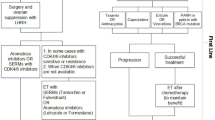Abstract
In a previous study, using differential display reverse transcriptase-PCR (DDRT-PCR) we showed that down-regulation of the PHLDA1 (pleckstrin homology-like domain, family A, member 1; also named TDAG51) mRNA was down-regulated in breast tumors compared with normal breast tissue. The present study was conducted to determine the expression pattern and predictive prognostic value of PHLDA1 in breast cancer. A series of 720 primary invasive breast tumors were examined for PHLDA1 expression. PHLDA1 mRNA expression was determined in 74 breast tumors using quantitative Real Time PCR analysis (qPCR). PHLDA1 protein expression was evaluated by immunohistochemistry (IHC) using Tissue Microarrays (TMA) containing 699 primary invasive breast tumors. Reduced PHLDA1 mRNA expression was identified in 72% (53/74) of the primary breast tumors analyzed. Seventy-three percent (512/699) of cases analyzed showed negative PHLDA1 protein expression. Down-regulation of PHLDA1 protein was a strong predictor of poor prognosis for breast cancer patients. Breast cancer patients with tumors that were negative for PHLDA1 protein expression had shorter disease free survival (P < 0.001) and overall survival (P < 0.001) than patients with tumors that were positive for PHLDA1 protein expression. In addition patients with tumors exhibiting reduced PHLDA1 expression and paucity for ER had the worse outcome (P < 0.001). Multivariate analysis indicated that PHLDA1 protein expression is an independent prognostic factor of patient survival. To our knowledge, the expression pattern of PHLDA1 in breast cancer has not previously been investigated. Our results provide strong evidence that reduced PHLDA1 expression is important in breast cancer progression and could serve as useful prognostic marker of disease outcome.




Similar content being viewed by others
References
Boyle P (2005) Breast cancer control: signs of progress, but more work required. Breast 14(6):429–438
Van ‘t Veer LJ, Dai H, et al (2002) Gene expression profiling predicts clinical outcome of breast cancer. Nature 415(6871):530–536
Rouzier R, Perou CM, Symmans WF et al (2005) Breast cancer molecular subtypes respond differently to preoperative chemotherapy. Clin Cancer Res 15:11(16):5678–5685
Folgueira MA, Carraro DM, Brentani H et al (2005) Gene expression profile associated with response to doxorubicin-based therapy in breast cancer. Clin Cancer Res 11(20):7434–7443
Duffy MJ (2005) Predictive markers in breast and other cancers: a review. Clin Chem 51(3):494–503
Nagai MA, Ros N, Bessa SA et al (2003) Differentially expressed genes and estrogen receptor status in breast cancer. Int J Oncol 23(5):1425–1430
Park CG, Lee SY, Kandala G et al (1996) A novel gene product that couples TCR signaling to Fas(CD95) expression in activation-induced cell death. Immunity 4(6):583–591
Kuske MD, Johnson JP (2000) Assignment of the human PHLDA1 gene to chromosome 12q15 by radiation hybrid mapping. Cytogenet Cell Genet 89(1–2):1
Gomes I, Xiong W, Miki T et al (1999) A proline- and glutamine-rich protein promotes apoptosis in neuronal cells. J Neurochem 73(2):612–622
Hossain GS, van Thienen JV, Werstuck GH et al (2003) TDAG51 is induced by homocysteine, promotes detachment-mediated programmed cell death, and contributes to the development of atherosclerosis in hyperhomocysteinemia. J Biol Chem 278(32):30317–30327
Toyoshima Y, Karas M, Yakar S et al (2004) TDAG51 mediates the effects of insulin-like growth factor I (IGF-I) on cell survival. J Biol Chem 279(24):25898–25904
Brentani MM, Nagai MA, Fujyama CT et al (1981) Steroid receptors in a group of Brazilian breast cancer patients. J Surg Oncology 18:431–439
Chomczynski P, Sacchi N (1987) Single-step method of RNA isolation by acid guanidinium thiocyanate-phenol-chloroform extraction. Anal Biochem 162:156–159
Neef R, Kuske MA, Prols E et al (2002) Identification of the human PHLDA1/TDAG51 gene: down-regulation in metastatic melanoma contributes to apoptosis resistance and growth deregulation. Cancer Res 62(20):5920–5929
Hardy K, Mansfield L, Mackay A et al (2005) Transcriptional networks and cellular senescence in human mammary fibroblasts. Mol Biol Cell 16(2):943–953
Green KA, Streuli CH (2004) Apoptosis regulation in the mammary gland. Cell Mol Life Sci 61(15):1867–1883
Fata JE, Werb Z, Bissell MJ (2004) Regulation of mammary gland branching morphogenesis by the extracellular matrix and its remodeling enzymes. Breast Cancer Res 6(1):1–11
Rho J, Gong S, Kim N et al (2001) TDAG51 is not essential for Fas/CD95 regulation and apoptosis in vivo. Mol Cell Biol 21(24):8365–8370
Acknowledgment
This work was supported by grants 03/13170–0 and 04/04607–8 from FAPESP.
Author information
Authors and Affiliations
Corresponding author
Rights and permissions
About this article
Cite this article
Nagai, M.A., Fregnani, J.H.T.G., Netto, M.M. et al. Down-regulation of PHLDA1 gene expression is associated with breast cancer progression. Breast Cancer Res Treat 106, 49–56 (2007). https://doi.org/10.1007/s10549-006-9475-6
Received:
Accepted:
Published:
Issue Date:
DOI: https://doi.org/10.1007/s10549-006-9475-6




